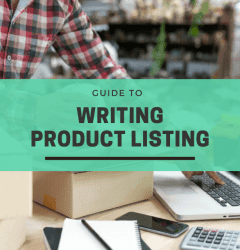This website uses cookies so that we can provide you with the best user experience possible. Cookie information is stored in your browser and performs functions such as recognising you when you return to our website and helping our team to understand which sections of the website you find most interesting and useful.
20 Dec

9 Tried-and-Tested Tips To Rank Higher on Amazon
Whether it’s a digital only brand or a multi-channel retailer, selling merchandise on the Amazon marketplace has now become a key component of the sales strategy for many. In fact, Amazon averages a 74% share (Source: Search Engine Watch) of digital transactions in the US alone; as the marketplace expands its footprints to other geographies, this number could be significantly higher. Amazon is in fact emerging as the preferred search engine for eCommerce customers with real purchase intent. Which is why 54% of product related searches (Source: Search Engine Watch) across the world happen on Amazon, while Google trails back at 46%.
However, ranking higher on Amazon is no easy feat; you need to get a sequence of actions in order at your end before you make this happen. Here’s how you can go about it:
1. Content Optimization
Optimizing product listings for the platform is the most critical key to the puzzle. Did you know that 19 out of 20 listings are not correctly optimized? Conversely, a good listing results in higher organic rank, better clicks and conversion ratio, all of which are necessary for business.
While any product listing has multiple elements, the overall idea is to ensure that your content is optimized on two parameters:
- For the users – To achieve this, the key decision making factors that drive the customers’ intent should be included in the content. For example: if you are selling cotton bedsheets and most users inadvertently look for silky and soft sheets, you must include this purchase factor throughout your content and also provide trust seals/ badges wherever possible to make consumers trust your product more.
- For the algorithm – To do this, you must include relevant keywords for indexing by the Amazon algorithm in your content (the important word here being ‘relevant’, because the better your product and its content matches to a given search term, the higher it will show up on the search results page). However, techniques like keyword stuffing, inclusion of irrelevant keywords to attract more traffic, or not adhering to Amazon guidelines, should be strictly avoided.
A good idea is to analyze the customer reviews and FAQs on your products as well as your competitor products in the same category, and understand the customer sentiment around it. This will help you when curating the content for your own listing. Some of the fundamental content elements of any listing on Amazon include title, product description, bulletin features, and backend search terms.
2. Focus on visual marketing for your product
Other than the written content, you must also put in efforts to optimize the visual elements of your listing (such as feature images, videos and A+ content). Some of the key elements to boost visual marketing for your Amazon listings are as follows:
- Imagery:
- Use bright, high-resolution images
- Ensure that main product attributes/ purchase factors (like size, color, dimensions, shape) are spelled out clearly in the images
- Make use of graphic images to show how products are to be used, what comes within the packaging, etc.
- Videos: You can use explainer videos and 360-degree product views to convert potential shoppers.
- A+ content: Using interactive and multimedia-rich content can help customers understand your products better and propel purchase decisions. We also recommend using split testing for your A+ content.
3. Price your product competitively
Pricing is the leading factor of purchases on Amazon, with 82 percent of Amazon buyers in the US listing it as the most important shopping consideration. Understanding what your target market is willing to pay for the product can help you hit the nail on the head. For this, you need to:
- Calculate your optimal price range by keeping your product costs, Amazon selling costs, marketing costs and product margins in mind
- Understand the price elasticity and industry trends for your category in the market
- Analyze your competitors’ pricing and promotions to stay ahead of them
- Identify which pricing model works best for your product and category, and test it to take action wherever necessary
4. Tackle negative reviews at the earliest
According to expert market studies, 86% of people hesitate to do business with a company if it has negative online reviews. So while the first step of the process will always be to deliver a fantastic product, if you’ve under-delivered on certain occasions and hence, earned a negative review, you need to have a plan to respond well to criticism too. Though as sellers you cannot directly influence the kind of reviews that you get, following are some useful tips:
- Ensure that you respond to buyer feedback, especially critical or negative ones, within 24 hours. You can do this using the ‘Feedback Manager’ option on Amazon.
- Ensure that the information you have included in your product description and content exactly matches what you are providing in the product.
- Address any customer pain points/ common product related assumptions in your content
5. Use Amazon Ads/PPC to increase your traffic and rank
Amazon, as a platform, has the capability to give brands just the push they need, as long as their advertising strategy is executed in the right means and ways. Moreover, unlike organic SEO, this method attracts visitors to your listing from the get-go, with a focused approach and greater objectivity. But how do Amazon Ads exactly help with ranking higher on the platform?
- Search Term Optimization: Investing in a carefully thought-out Amazon ads strategy can help drive visibility and traffic on relevant keywords. Amazon essentially wants to show those listings at the top of search results that are more likely to convert shoppers. If the ads that you show convert for the terms that potential buyers search for, it helps Amazon associate your product with that particular term. This ultimately feeds back into the organic rankings too.
- More Brand Awareness: Your main goal might be to rank for a lot of high-traffic, non-branded terms on Amazon to increase your total addressable market on the platform. However, if you are able to increase the number of buyers who are converting on your branded search terms, you will still see a spike in organic traffic. In the long term, the better your brand is known, the more direct traffic you will get overall.
- Better Customer Lifetime Value: This can be another way to think of brand building. If you know that some of your products are more likely to get you repeat purchases, or “hero” products that generally help you get a higher average order value, you can use these as great options for PPC targeting. In the long run, these will get you higher traffic and hence, better organic ranking on the platform.
6. Manage your inventory effectively
Selling products on Amazon is a high volume game. Hence, when you are going all out to market your listing and drive conversions for your products, make sure that you are well-prepared to tackle large spurts in demand.
- High Out-of-Stock rate reduces the chances of winning Buy Box, resulting in low sales. To avoid this, manage your inventory better and attempt to restock items in the shortest window possible after you exhaust a certain SKU. Keep your eye on items that sell-out quickly and replenish them soon.
- Create inventory forecasts and plans for at least a 6 month period to get your supply chain and other logistics in place. These processes must be kept under an even tight watch, especially during festive seasons.
- Some factors to consider when planning inventory are as follows:
- Demand (sales forecasts depending on historic trends, high traffic periods like Prime Day, Black Friday, Post sales spike anomalies)
- Lead time & other logistics
- Trends of past stockouts & sales velocity
- Product type – whether fast moving or slow moving product
- Marketing efforts – whether you are planning to go super aggressive on marketing activities such as ad spends, promotions, deals, etc. on some products
- Restock limits at Amazon warehouses, if using FBA
7. Ensure better delivery & shipping mechanisms
One of the sure-shot ways to ensure that you rank better and increase your chances of winning the Buy Box is by offering hassle-free and fast shipping to customers.
For this purpose, Fulfilment by Amazon (FBA) is a unique service offered by Amazon that removes the retailer’s burden of storing, packing, and shipping orders as well as handling returns and exchanges. Believe it or not, this service gives sellers a 30-50% increase in sales.
There are also other similar options available like SFP (Seller-Fulfilled Prime). The idea is to improve your seller metrics through displaying the Prime badge and fulfilling orders with a two-day window for no additional charge.
8. List your product in the right category
Listing your product within the right category & subcategory on Amazon helps with better indexing, better ranking and also a better customer experience. For example: if you’re selling a hair-dryer online, the most relevant parent-child variation would be to enlist the product under Electric Appliances under the Hair and Beauty category. Incorrect categorization can make it very difficult for customers to find you on the eCommerce behemoth, thereby affecting discoverability, visibility, and sales.
9. Update. Optimize. Repeat
As an e-tailer, you must continuously analyze concrete data to get better actionable insights for your business. In our experience of working with 50+ brands on Amazon, a good idea is to leverage the various data points provided through specific reporting tools directly by Amazon, such as Amazon Brand Analytics, Amazon Pi, etc. Few examples are as follows:
- You can track the click share for your products using Amazon Brand Analytics. This can help you understand what competitors are taking your market share, and help create ad campaigns to drive traffic back to your products.
- You can monitor the sales diagnostics for your products, post scaling up of ad spends. This will help you understand the impact of PPC on organic sales and align your business goals based on the impact.
- You can use experiments under Brand Analytics to drive greater insights about your online user trends, and make modifications to your A+ content, product listing, storefront, etc.
All in all, for most retailers, Amazon is a critical part of the online sales mix. In order to reach more people and do better business on the platform, you must learn the nuances of the platform and understand how to reach more people, drive impressions, build positive word-of-mouth and in turn, attract greater repeat sales. In order to achieve all this, one must rank higher on the platform, which is not a hard task – just one that demands oodles of patience and consistency!
Related Post
Industries Served
United States
India













